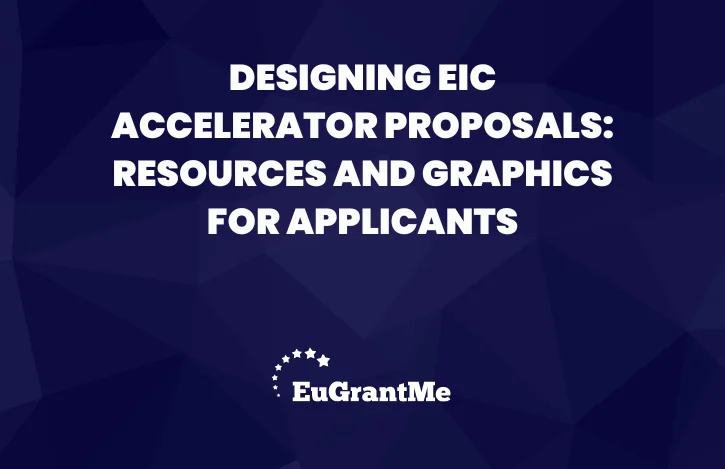Creating a compelling proposal for the EIC Accelerator can be challenging. However, leveraging the right resources and graphics can enhance the application’s quality and readability. This article provides guidance for applicants on utilising these tools effectively to increase their chances of success.
The Importance of Visuals in EIC Accelerator Proposals
Visual elements are essential for any EIC Accelerator proposal. They convey complex information concisely and effectively. When crafting a proposal, use graphics to support key messages and provide clarity. Diagrams, flowcharts, and infographics help the evaluator understand the project at a glance. For instance, showcasing the technical aspects or market positioning can be much clearer with visual aids.
Moreover, visuals create engagement. Long blocks of text can be overwhelming. Complement them with visual elements to improve reader retention. This can be particularly useful when explaining innovation strategies, business models, or expected project impacts.
Resources to Support Your Proposal Development
Numerous resources can aid in drafting a compelling EIC Accelerator proposal. A good starting point is to familiarise yourself with the official EIC Accelerator Guide for Applicants. This document provides detailed information on proposal structure, evaluation criteria, and submission guidelines. Understanding these aspects is crucial for tailoring your content.
In addition, external guides and toolkits offer valuable templates and examples. These can serve as a reference for structuring each section of your proposal. Consider using proposal software platforms that feature collaborative tools and templates. These platforms allow teams to work together in real-time, ensuring a cohesive narrative.
Creating Effective Graphics for EIC Proposals
High-quality graphics are a critical component of a well-designed proposal. Use them to highlight key points and differentiate your application from others. Graphs and tables are ideal for presenting numerical data, while flowcharts are excellent for illustrating processes.
When designing graphics, keep them simple and focused. Each visual should convey a single, clear message. Avoid cluttered designs or excessive colours, as these can distract from the content. Always ensure that your visuals are directly relevant to the section they support.
Tools for Creating Professional-Grade Graphics
Several tools can help you create professional graphics for your EIC Accelerator proposal. Software like Adobe Illustrator or Inkscape is excellent for designing custom diagrams. For less design-intensive projects, platforms like Canva or Visme offer user-friendly interfaces with a wide selection of templates.
Using these tools, you can create graphs, charts, and other visual elements that enhance the proposal’s appeal. These platforms also offer collaborative features. These are particularly useful for projects involving multiple stakeholders. Design elements can be reviewed and refined in real-time, ensuring that all aspects align with the overall proposal strategy.
Aligning Resources and Graphics with Proposal Sections
Each section of the EIC Accelerator proposal has distinct requirements. Tailor your resources and graphics accordingly. In the “Excellence” section, use visuals to explain technical innovations. In the “Impact” section, consider graphics that depict market trends or growth projections.
For the “Implementation” section, Gantt charts and process diagrams are particularly useful. They illustrate timelines, key milestones, and project workflows clearly. Incorporating these elements strengthens your narrative, demonstrating that the project is well-planned and feasible.
Incorporating Visual Storytelling in Proposals
Visual storytelling can significantly enhance the effectiveness of your EIC Accelerator proposal. Storytelling combines textual and visual elements to create a coherent narrative. This approach can make technical content more accessible. Start by identifying the core message of each section. Then, use graphics to complement and reinforce that message.
For instance, in the “Impact” section, a visual representation of the target market and its needs can clarify your market strategy. Similarly, in the “Implementation” section, a roadmap visual can effectively communicate the project’s development stages.
Reviewing and Refining Your Proposal
Once your proposal draft is complete, review it with a focus on coherence and visual appeal. Ensure that your resources and graphics align with the written content. Evaluate whether the visuals support or detract from the main narrative. It can be helpful to get feedback from external reviewers. They can provide an unbiased perspective on your use of visual elements.
Additionally, refine your visuals for consistency. Use a uniform style for all graphics, including fonts, colours, and layout. This creates a professional look and ensures that the proposal appears cohesive and well-organised.
Designing EIC Accelerator proposals requires a strategic approach. The use of well-crafted resources and graphics can make a significant difference. By following best practices, applicants can create compelling proposals that resonate with evaluators. Leverage visuals to clarify complex ideas, support key messages, and enhance the overall presentation. Doing so will not only improve the proposal’s clarity but also its impact, increasing the likelihood of success in the EIC Accelerator programme.
At EuGrantMe, we are passionate about fostering innovation and empowering ambitious minds to flourish. Our mission revolves around providing top-notch grant writing services for the EIC Accelerator and Horizon grants in Europe. We enable our customers to unlock the full potential of their ground-breaking ideas.
Do you have a project to turn into reality?
Contact us!


